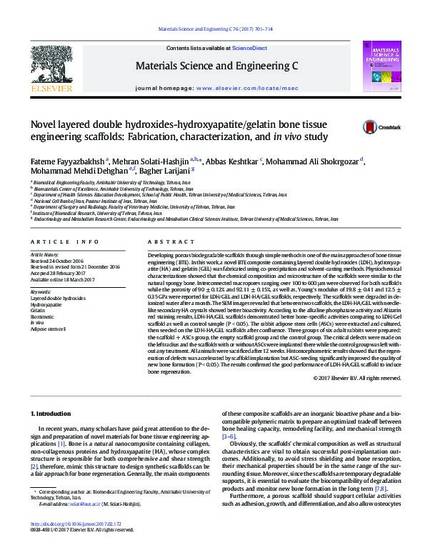
Developing Porous Biodegradable Scaffolds through Simple Methods is One of the Main Approaches of Bone Tissue Engineering (BTE). in This Work, a Novel BTE Composite Containing Layered Double Hydroxides (LDH), Hydroxyapatite (HA) and Gelatin (GEL) Was Fabricated using Co-Precipitation and Solvent-Casting Methods. Physiochemical Characterizations Showed that the Chemical Composition and Microstructure of the Scaffolds Were Similar to the Natural Spongy Bone. Interconnected Macropores Ranging over 100 to 600 Μm Were Observed for Both Scaffolds While the Porosity of 90 ± 0.12% and 92.11 ± 0.15%, as Well As, Young's Modulus of 19.8 ± 0.41 and 12.5 ± 0.35 GPa Were Reported for LDH/GEL and LDH-HA/GEL Scaffolds, Respectively. the Scaffolds Were Degraded in Deionized Water after a Month. the SEM Images Revealed that between Two Scaffolds, the LDH-HA/GEL with Needle-Like Secondary HA Crystals Showed Better Bioactivity. According to the Alkaline Phosphatase Activity and Alizarin Red Staining Results, LDH-HA/GEL Scaffolds Demonstrated Better Bone-Specific Activities Comparing to LDH/Gel Scaffold as Well as Control Sample (P < 0.05). the Rabbit Adipose Stem Cells (ASCs) Were Extracted and Cultured, Then Seeded on the LDH-HA/GEL Scaffolds after Confluence. Three Groups of Six Adult Rabbits Were Prepared: The Scaffold + ASCs Group, the Empty Scaffold Group and the Control Group. the Critical Defects Were Made on the Left Radius and the Scaffolds with or Without ASCs Were Implanted There While the Control Group Was Left Without Any Treatment. All Animals Were Sacrificed after 12 Weeks. Histomorphometric Results Showed that the Regeneration of Defects Was Accelerated by Scaffold Implantation But ASC-Seeding Significantly Improved the Quality of New Bone Formation (P < 0.05). the Results Confirmed the Good Performance of LDH-HA/GEL Scaffold to Induce Bone Regeneration.
- Adipose stem cell,
- Biomimetic,
- Gelatin,
- Hydroxyapatite,
- In vivo,
- Layered double hydroxides
Available at: http://works.bepress.com/fateme-fayyazbakhsh/10/

Faculty of Veterinary Medicine, Cairo University, Grant 88002447